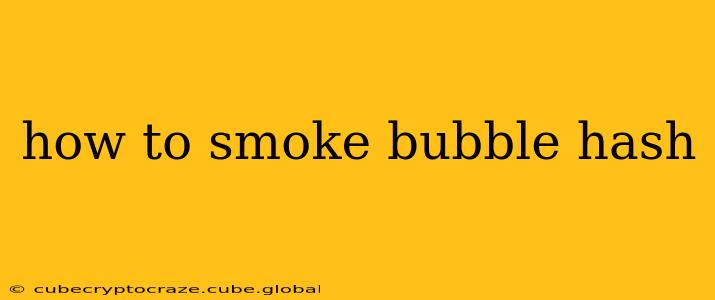Bubble hash, known for its potent effects and smooth smoke, is a highly sought-after cannabis concentrate. This guide will walk you through various methods of smoking bubble hash, highlighting the pros and cons of each to help you choose the best approach for your preferences. We'll also address some frequently asked questions surrounding this popular concentrate.
What is Bubble Hash?
Before diving into consumption methods, let's quickly define bubble hash. It's a type of cannabis concentrate made using water and ice to separate trichomes (the resin glands containing cannabinoids and terpenes) from the plant material. This process produces a potent, clean, and often flavorful concentrate that comes in various consistencies, from a dry, powdery kief to a sticky, almost putty-like substance. The quality and consistency depend on the filtration process and the starting plant material.
Methods for Smoking Bubble Hash
Several methods can be used to enjoy your bubble hash, each offering a unique experience:
1. Smoking Bubble Hash in a Joint or Blunt:
This is a classic and straightforward method. You can mix your bubble hash with your preferred cannabis flower for a balanced smoke, or use it as a kief topping for a more potent effect.
Pros: Easy, accessible, customizable.
Cons: Can be harsh if not mixed properly, potential for uneven burning.
2. Smoking Bubble Hash in a Pipe or Bong:
A pipe or bong provides a more direct and potent hit. You can place a small amount of bubble hash directly into the bowl or on top of your flower. Using a dab rig or dedicated hash pipe is recommended for a cleaner and more efficient smoking experience.
Pros: Potent, efficient, direct experience.
Cons: Requires careful temperature control to prevent harshness or burning.
3. Vaping Bubble Hash:
Vaping bubble hash offers a cleaner, healthier alternative to combustion. A dedicated vape pen designed for concentrates works best, or some larger vaporizers accommodate hash as well. It’s crucial to choose a vape with a suitable temperature setting to avoid harsh vapor or combustion.
Pros: Cleaner inhalation, better preservation of flavor and aroma.
Cons: Requires a specialized device, learning curve for optimal temperature.
4. Dabbing Bubble Hash:
Dabbing is a popular method among concentrate users, offering incredibly potent hits through rapid vaporization at high temperatures. This involves using a dab rig, a specialized device designed for dabbing concentrates.
Pros: Extremely potent and efficient.
Cons: Requires a dab rig and specific skills and understanding to avoid accidental burns.
Frequently Asked Questions (FAQs)
How potent is bubble hash?
The potency of bubble hash varies depending on the quality of the starting material and the extraction process. It generally contains a higher concentration of THC than flower, often ranging from 40% to over 70%.
What's the difference between bubble hash and other concentrates?
While other concentrates like shatter, wax, or oil are also potent, bubble hash stands out due to its unique production method (water/ice extraction). This often results in a smoother, cleaner, and potentially more flavorful experience compared to solvent-based extracts.
Is it safe to smoke bubble hash?
As with any cannabis product, smoking bubble hash carries potential risks. It’s essential to source your product from reputable sources to minimize the risk of contamination. Be mindful of your tolerance and start with small amounts.
What are the potential side effects of smoking bubble hash?
Common side effects include dry mouth, dry eyes, increased heart rate, and altered perception. These side effects are usually temporary and subside after the effects wear off. However, individuals with underlying health conditions should consult a medical professional before using cannabis.
This guide provides a general overview of smoking bubble hash. Always prioritize safety and responsible consumption. Experiment with different methods to find what best suits your personal preference and always be aware of the potential risks associated with cannabis use.
